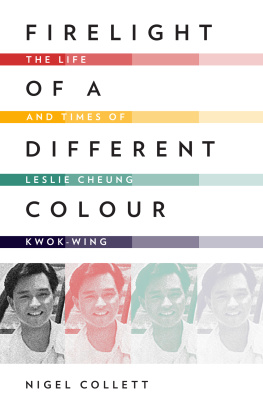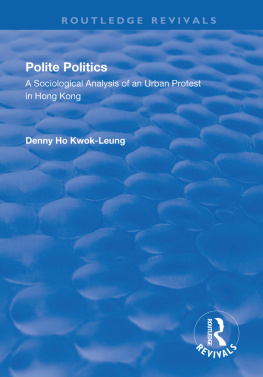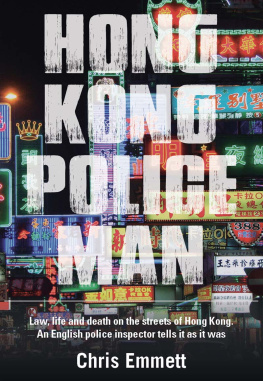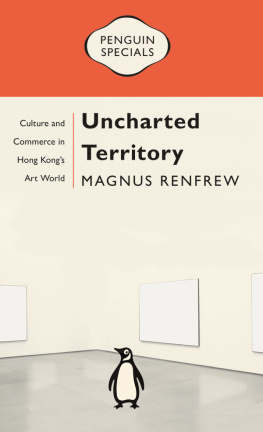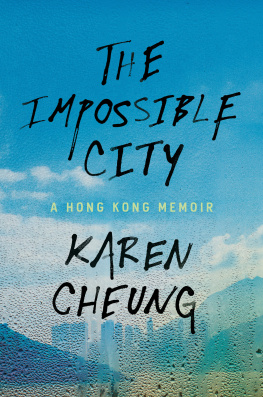
FIRELIGHT OF
A DIFFERENT
COLOUR

Firelight of a Different Colour:
The Life and Times of Leslie Cheung Kwok-wing
By Nigel Collett
Published by Signal 8 Press
An imprint of Typhoon Media Ltd
Smashwords Edition
Copyright 2014 Nigel Collett
eISBN: 978-988-15542-0-8
Typhoon Media Ltd:
Signal 8 Press | BookCyclone |Lightning Originals
Hong Kong
www.typhoon-media.com
All rights reserved. No part of this book may be reproduced in any form or by any means, except for brief citation or review, without written permission from Typhoon Media Ltd.
Cover design: Justin Kowalczuk
Cover photo credit: Amanda Lee and Jamie Law
Dedicated to the memory of
Leslie Cheung Kwok-wing and to the
many who keep it alive
CONTENTS
ACKNOWLEDGEMENTS
T his biography grew from a discussion with Ms Annabella Choi, my business adviser and friend, and I thank her warmly for encouraging me to write it. She also introduced me to two people without whose help I could never have begun: JoJo and Julie of Leslie Cheung Cyberworld, two of the key figures in the continued commemoration of Leslie in Hong Kong and two focal points of the worldwide web of Leslies admirers. Jojo and Julie introduced me to the fans who live in or visit Hong Kong, invited me to the commemorative events they help to organise, and helped me find much of the published material that made this book possible. This was in many languages and came from many volunteers in different countries. Jojo and Julie contacted these and sought information from them. They were tireless in giving help and advice. I am indebted immeasurably to them and thank them and their colleagues and friends across the world most warmly. I would particularly like to thank Amanda Lee, one of the principal among Leslies fans, for her very kind help and information about them.
The web site of Leslie Cheung Cyberworld is at: http://www.lesliecheung.cc/ .
I would also like to thank Father Francisco de las Heras, Supervisor and Principal of Rosaryhill School, for allowing me to visit the school and for talking to me about Leslies time there. I thank the principal of Buddhist Wong Fung Ling College for allowing me the privilege of visiting and Ms Anna Sum for showing me the college. I thank Ms Alice Leung of the Education and Manpower Bureau of the Government of the Hong Kong S.A.R. for information on Wellington College. I warmly thank Mr Sean Symington, proprietor of New Eccles Hall School, Norfolk, for allowing me to visit the school and for providing documentation and information about Leslies time there.
Many people have helped me with information about Leslies life who wish to remain anonymous, particularly those who provided information about his part in Hong Kongs gay scene, and I thank them all here.
I would like to thank who researched and corrected many of the details of the book and whose advice was invaluable.
Finally, I wish to thank warmly my publisher, Marshall Moore, for taking on this work and guiding me through to its completion.
Any mistakes, and the opinions expressed in this book, are, of course, the authors own.
Nigel Collett
Hong Kong
2013
INTRODUCTION
O n the 1st of April, 2003, Hong Kong was stunned by the news that superstar Leslie Cheung Kwok-wing had died at the age of 46. Despite the date, this was no April Fool. The news sent Hong Kong into shock. Crowds gathered and stayed outside the Mandarin Oriental Hotel in Central, adding flowers to the growing mound on the spot where his body had been found. The media, already immersed in the gloom of the SARS epidemic, then at its height in the territory, hastily abandoned other stories and focussed on his death. Beyond Hong Kongs borders, across the whole Chinese world and throughout eastern Asia, the shock waves rippled outwards, spreading dismay, sorrow, incomprehension, and grief.
The next day, the Cheung family released a notice of Leslies death, as customary listing those closest to him, but, uniquely for Hong Kong, heading the list with the name of a man, Daffy Tong Hok-tak, who was shown as his closest love.
Already depressed by SARS and the economic crisis, which were both then ravaging the city, Hong Kong went into mourning as if for royalty. Radio shows played memorial music throughout the day and their lines were clogged with people calling in, many in tears. The websites of his innumerable fans opened memorial books, only to become inaccessible for days due to the enormous number of hits they received. Five days after his death, while Leslies body lay at rest in a funeral parlour, over 500 fans braved the fear of SARS (which had closed cinemas, restaurants and even church services) to gather outside the Mandarin for an evening ceremony. They displayed posters of his face, sang his songs, and chanted prayers. Most spent the entire ceremony in tears.
The family arranged for Leslies casket (but not his body, which was not shown at any ceremony) to be available for view at the funeral home on 7 April. The press had first view from 5 to 5.30 pm and the two hours from 6 to 8 pm were allotted to his fans. This proved totally inadequate, as huge numbers gathered outside, some of them having flown in from around the world. They had begun to line up at seven oclock that morning and by evening there were some 10,000 queuing around the funeral home, humming and singing Leslies songs, wearing white ribbons, and folding paper swans, a symbol of blessing. Everyone had been asked to wear a surgical mask and to stand apart from each other to prevent the contagion of SARS, but this was wildly impractical advice in the crush that developed and was ignored. Flowers filled the funeral home and burst out all around it. Doors were opened early, at 5.20, to ease the strain, and fifty at a time were allowed in for one minute each. Most took off their masks inside and wept openly. When the doors were scheduled to close, those still outside refused to go home, and mourners continued to troop past the coffin until 11 pm.
Celebrities attended the viewing in large numbers, including stars Anita Mui Yim-fong, Cherie Chung Chor-hung, Anita Yuen Wing-yi, Chow Yun-fat, and comedienne Lydia Shum Din-ha, popularly known as Fei-Fei. Cherie Chung broke down in the funeral lobby and had to be supported out. Singer/actor Jacky Cheung Hok-yaus actress wife, May Law Mei-mei, shook so badly that she had to be helped away. Many of the stars were in tears. Anita Yuen collapsed when she saw Leslies photographs, which had been placed around the room, and had to be helped to her feet. Anita Mui, his closest friend, stayed for two hours and broke down completely.
The funeral service followed by cremation took place the next day. In the notice placed in the press, again uniquely, Leslies family listed Daffys name in the place reserved for the surviving spouse. TV clips of Leslies shows were screened during the ceremony and at the end a series of slides of Leslie and Daffy were shown. By then, Daffy could barely stand.
With Daffy bringing up the rear, Leslies casket was borne out by eight celebrities, a galaxy of Hong Kongs glitterati, including representatives of its showbiz industry and men who had known Leslie through his career, gently lifting, then solemnly bearing the coffin enclosing the body of their dead friend, now on his last, sad journey. As the hearse drove out, with Leslies niece in front next to the driver, the fans called out Leslie and his nickname Gor Gor; two of them fainted on the spot. Through streets blocked off by the police, the cortege made its way to Cape Collinson crematorium, where it arrived at 12.45 to find many more fans assembled. Celebrities crowded into the crematorium; there were more cries of Leslies name; the coffin was carried inside, where Daffy, in desperate agony and weeping incessantly, pressed the button to consign it to the furnace.
Next page
